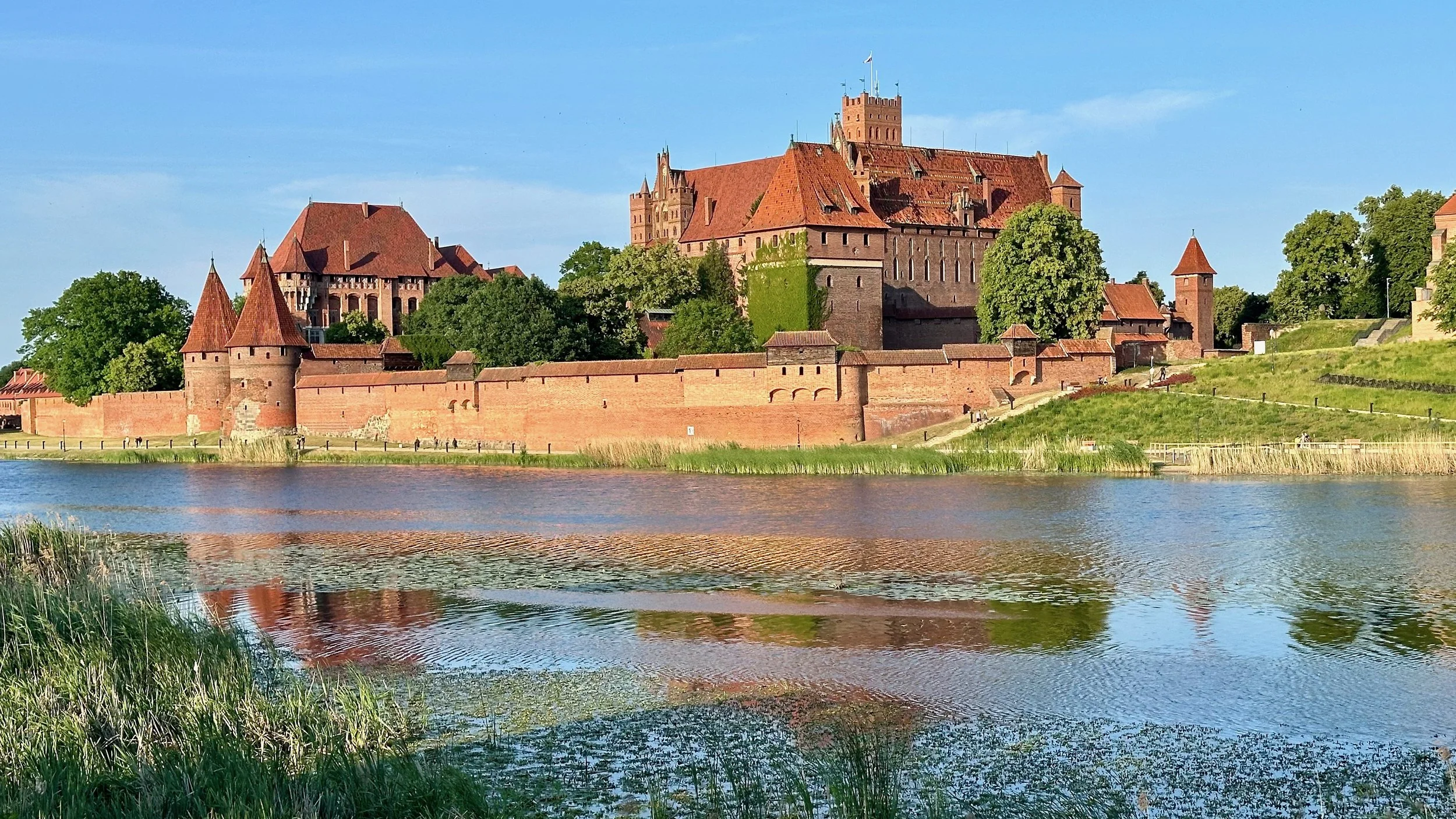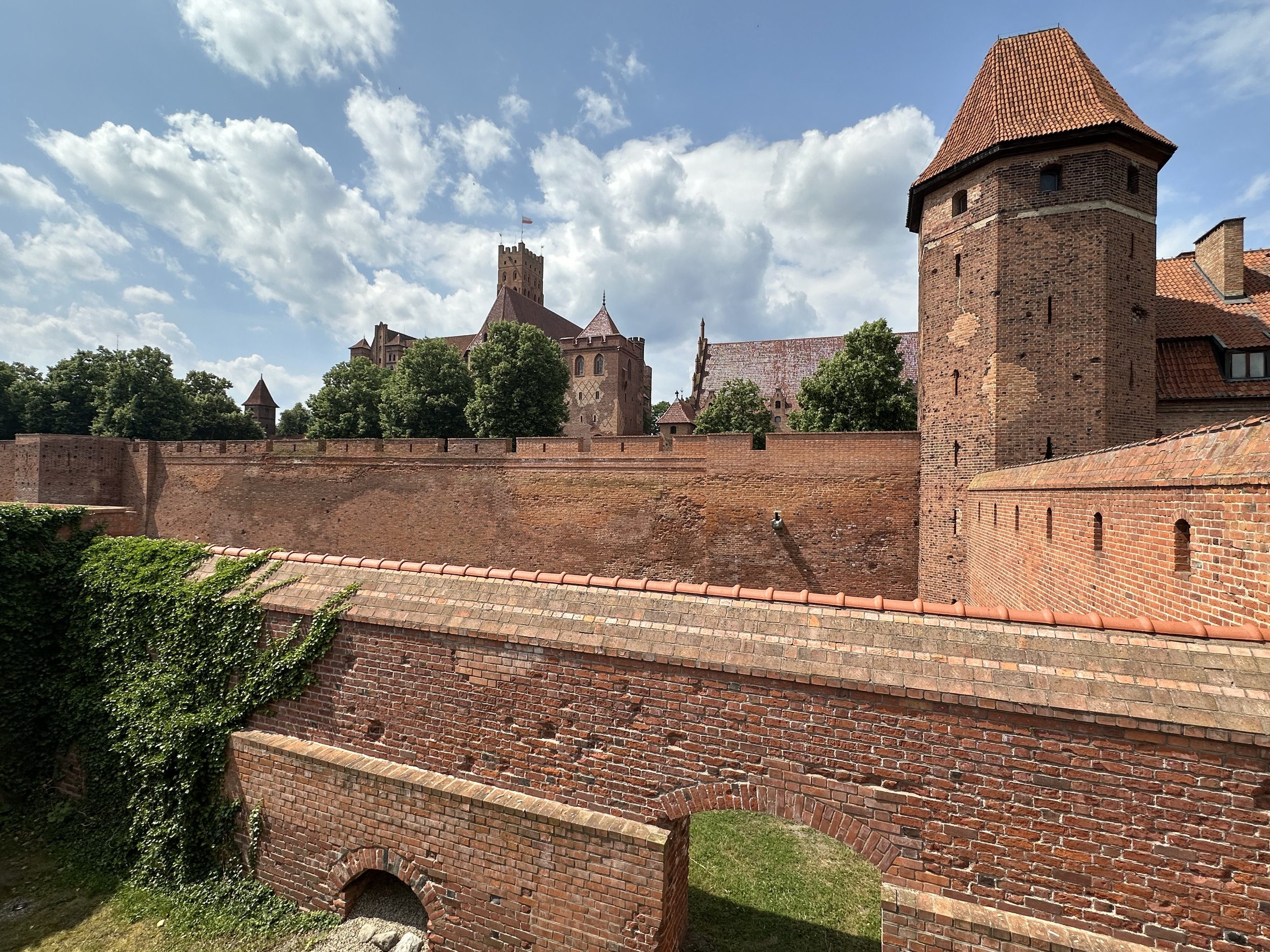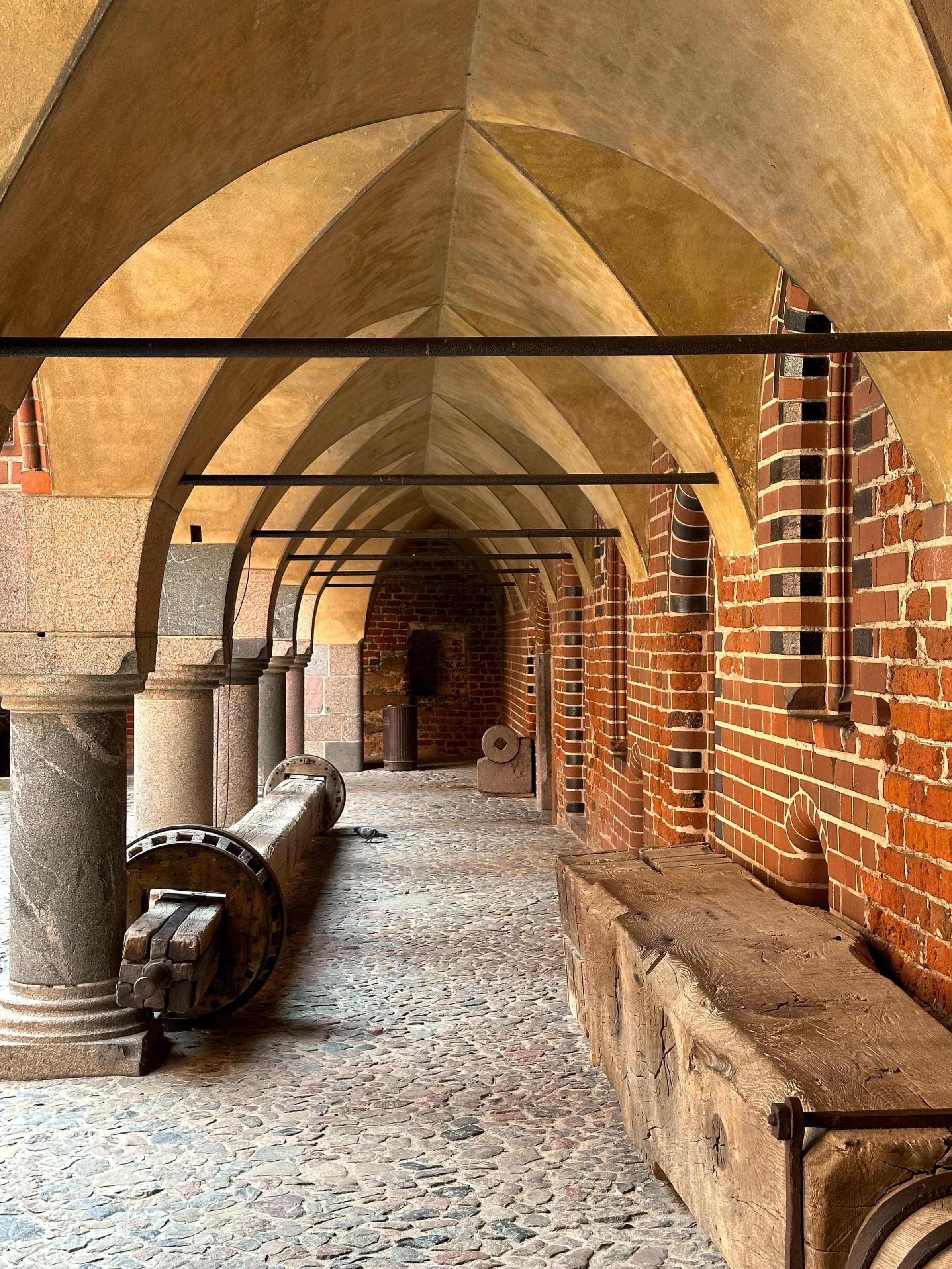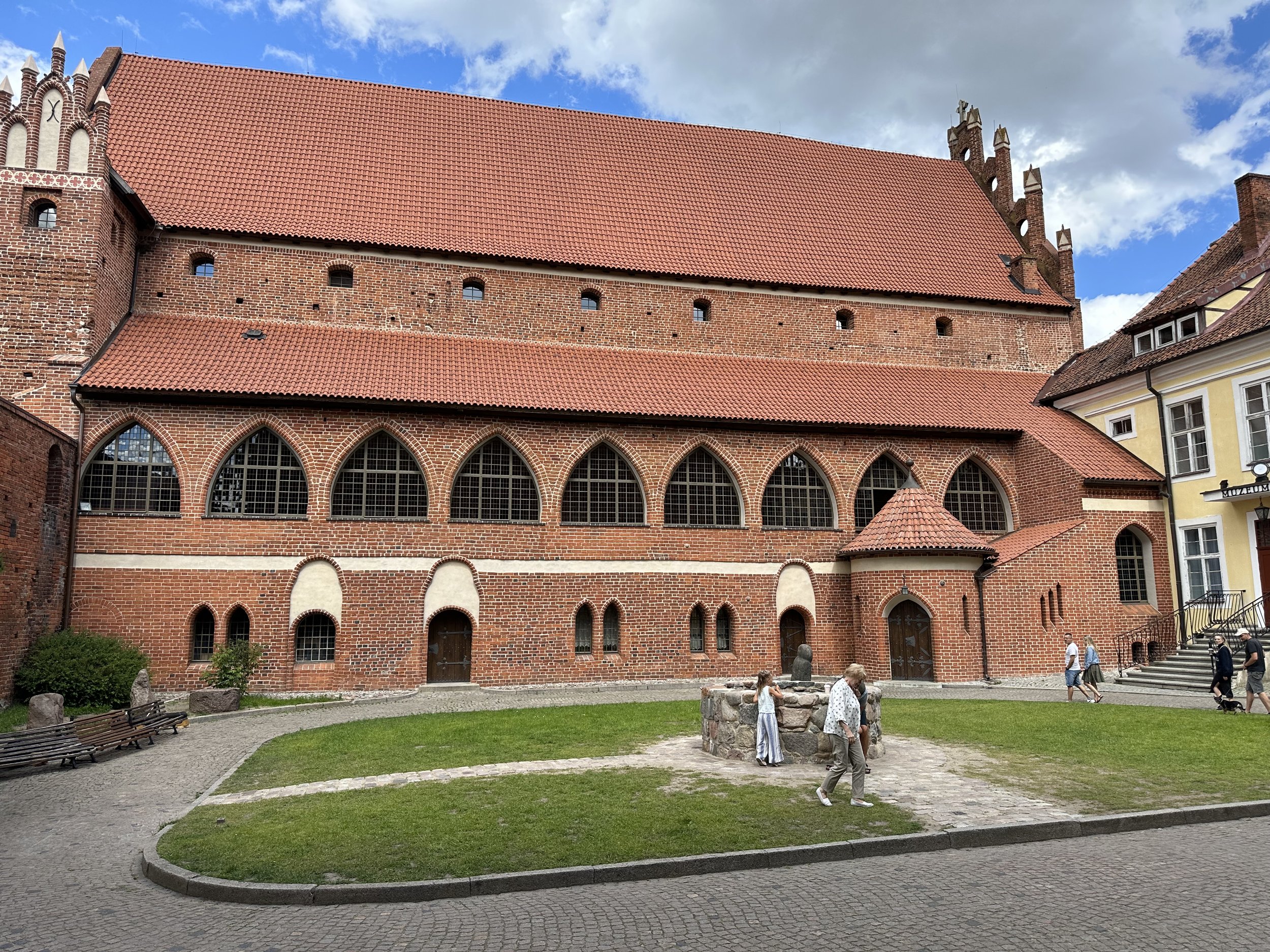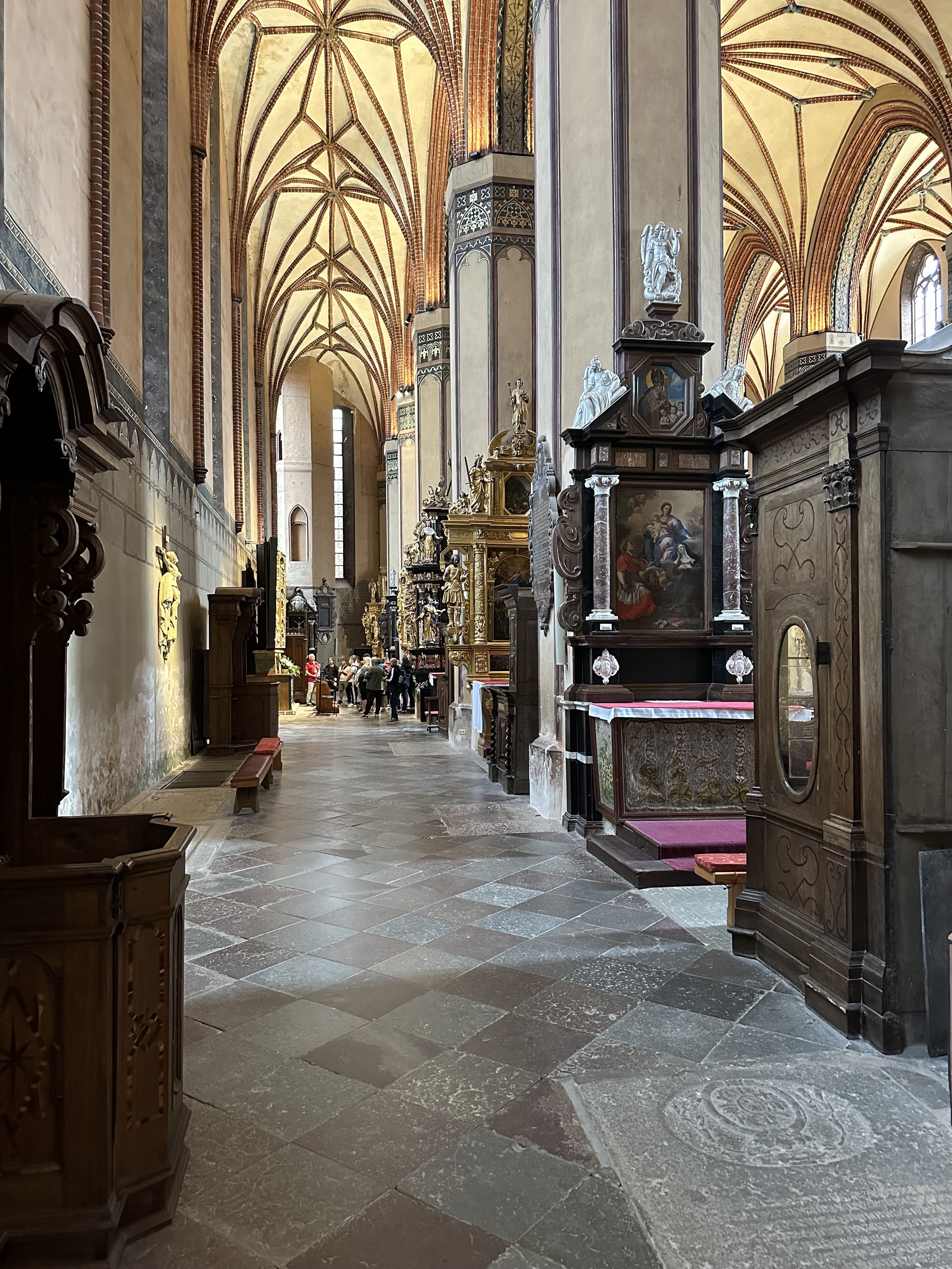Malbork - The capital of the Teutonic Order
Malbork Castle is located in the north of Poland, on the east bank of the River Nogat. It is the most complete and elaborate example of a Gothic brick-built castle complex in the characteristic and unique style of the Teutonic Order. The Teutonic Order State was founded in the 13th century by German communities of military monks who carried out crusades against the pagan Prussians and Lithuanians living on the south Baltic coast, as well as against the Christian Kingdom of Poland. It reached its greatest influence in the 14th century. The castle-convent embodies the drama of late medieval Christianity, straining between extremes of sanctity and violence. Malbork Castle consists of three fortified castles, with several hundred houses, granaries, and other buildings surrounded by two rings of defensive walls. The castle today is beautifully restored. Its labyrinth of rooms, turrets, stairways, and halls contains a vast collection of amber, armour, paintings, and furnishings. It remains a unique example of the building style of the Teutonic Order.
The castle was built by the Teutonic Order after the conquest of Old Prussia. Its main purpose was to strengthen their own control of the area following the Order's 1274 suppression of the Great Prussian Uprising of the Baltic tribes. No contemporary documents survive relating to its construction, so instead the castle's phases have been worked out through the study of architecture and the Order's administrative records and later histories. The work lasted until around 1300, under the auspices of Commander Heinrich von Wilnowe. The castle is located on the southeastern bank of the river Nogat. It was named Marienburg after Mary, patron saint of the religious Order. The Order had been created in Acre (present-day Israel). When this last stronghold of the Crusades fell to Muslim Arabs, the Order moved its headquarters to Venice before arriving in Poland.
Malbork became more important in the aftermath of the Teutonic Knights' conquest of Gdañsk (Danzig) and Pomerania in 1308. The Order's administrative centre was moved to Malbork from Elblag (Elbing). The Grand Master of the Teutonic Knights, Siegfried von Feuchtwangen, who arrived in Malbork from Venice, undertook the next phase of the fortress construction. In 1309, in the wake of the papal persecution of the Knights Templar and the Teutonic takeover of Danzig, Feuchtwangen relocated his headquarters to the Prussian part of the Order's monastic state. He chose the site of Marienburg conveniently located on the Nogat in the Vistula Delta. As with most cities of the time, the new centre was dependent on water for transportation.
The castle was expanded several times to house the growing number of Knights. Soon, it became the largest fortified Gothic building in Europe, on a nearly 21 ha site. The castle has several subdivisions and numerous layers of defensive walls. It consists of three separate castles - the High, Middle and Lower Castles, separated by multiple dry moats and towers. The castle once housed approximately 3,000 'brothers in arms'.
The favourable position of the castle on the river Nogat allowed easy access by barges and trading ships arriving from the Vistula and the Baltic Sea. During their governance, the Teutonic Knights collected river tolls from passing ships, as did other castles along the rivers. They controlled a monopoly on the trade of amber. When the city became a member of the Hanseatic League, many Hanseatic meetings were held there.
In the summer of 1410, the castle was besieged following the Order's defeat by the armies of Wladyslaw II Jagiello and Vytautas the Great (Witold) at the Battle of Grunwald. Heinrich von Plauen successfully led the defence in the Siege of Marienburg (1410), during which the city outside was razed.
Olsztyn
Olsztyn Castle is a brick gothic castle located in the centre of Olsztyn in northern Poland. Officially called the Castle of Warmian Cathedral Chapter in Olsztyn, the Castle is not large. Olsztyn Castle wasn’t intended to be an actual residence for the Chapter. Instead, the Chapter wished to have an administrative centre for overseeing its own interests during the settlement process in this part of Warmia.
During the mid-14th century, the Chapter didn’t hold any notable defensive aspirations concerning the building of the Castle. This is because the area was no longer under threat from the Lithuanians. In contrast, the Chapter’s primary objective was to demonstrate its feudal grip over Olsztyn.
Olsztyn Castle was never directly in the hands of the Teutonic knights. Nevertheless, Warmia was politically dependent on the Teutonic Order. Therefore, the safety of the bishop’s dominion was ensured. The most distinctive feature of the cloister is the chart of the spring equinox drawn by astronomer Nicolaus Copernicus in 1517. Drawn on plaster work, this table is a record of an experiment carried out by Copernicus between 25 January and 20 April of that year.
Just below the chart is the entrance to the residential apartment once occupied by Copernicus. He was the administrator of the Castle in the years 1516-19 and 1520-21.
Frobmork - The resting place of Copericus
Frombork was first mentioned in 1278 – a few years later the cathedral in nearby Braniewo burnt down and the local bishop of Warmia decided to move the Warmia Chapter to Frombork. The original German name of the town (the area was under the Teutonic Order rule then) – “Frauenburg” – means it is dedicated to Virgin Mary.
For centuries Frombork developed as in fact two separate entities – the Cathedral Hill and the town around – they got united only in 1926.
Since Frombork has been one of the most popular religious, cultural, and educational centers in the region, it attracted numerous wise people, the most famous one was of course astronomer Nicolaus Copernicus.
The official name of Frombork Cathedral is Archcathedral Basilica of the Assumption of the Blessed Virgin Mary and St. Andrew and it was built in the 14th century (with further additions, like spires from the 16th century). This is one of the most spectacular churches you can see in Poland, it impresses both outside and inside with its Gothic architecture.
After a stint in city of Olsztyn, Copernicus's remains returned to his original resting location (under the cathedral’s floor), but his grave got an upgrade. After his death in 1543 he lay for centuries in an unmarked grave, but his new plot has a black tombstone with six planets orbiting a golden sun. The ceremony concluded a several week tour of a wooden casket with the astronomer’s remains. The ceremony included shows of respect from the Catholic Church, which eventually had to admit that Copernicus was right about the whole planets-moving-around-the-sun.
Scientists found what they believed to be Copernicus’s body in 2005, and confirmed in 2008 that it was his by matching DNA from bones found at the cathedral with genetic data from hair tucked into one of the astronomer's books.
Bytòw
The castle in Bytów was built by the Teutonic Knights in 1398-1405. The major construction works were supervised by Nicolaus Fellensteyn, a master builder of the Order. The construction of the castle fell to the period when Jacob von Reinach was the procurator of Bytów and Konrad von Jungingen was the Order's Grand Master. The castle was located on a hill, towering above the town, which guaranteed excellent natural defence. The castle, very modern for those days, was a seat of the local administration officials, a border fort and a stopover for knights arriving from western Europe to Malbork. The seat of the Bytów procurator, the castle, most probably housed from a few to more than a dozen knights accompanied by their pages and lansquenets. The complete crew of the castle could count a few dozens.
During the Thirteen Years' War (1454-1466) Bytów Castle was ceded by the towns people of Gdańsk to the Polish King, Kazimierz Jagiellończyk. In 1454 it was granted by the King to the Duke of Pomerania, Eric II, whose family, the Gryfits, ruled the castle and the lands of Bytów until the death of the last member of the dynasty, Bogusław XIV. The castle, enlarged by the Gryfit dukes in the second half of the 16th century, became a seat of the local administration officials in the early 17th century and a summer residence of Pomeranian dukes.
Lidzbark Warminski
Lidzbark Gothic Castle was built in 1350-1401 on a site previously occupied by a small Prussian fort called Lecbarg, which had been situated between two rivers: the Łyna and the Symsarna. For many years Lidzbark Castle was a residence of the bishops of Warmia and a stronghold protecting the eastern border of their domain.
The basic structure of the castle consists of four wings enclosing the inner ward, surrounded by two-storey, arcaded wall walks, which are an only example in Poland of Gothic castle walks preserved in an ideal condition until our days. Two settlements outside the castle walls were built around the same time as the castle. The southern one contained a stable for horses, granaries and a coach house. In the northern one (industrial in character) there was a mill, a sawmill, a grinding workshop, a copper forge, a fulling mill and a tannery. The castle and the two settlements were surrounded by a ring of fortified walls, separate from the town, and moats supplied with water from the Symsarna river, which lies higher than the Łyna.
By the power of the Second Peace Treaty of Torun signed in 1466, Warmia was incorporated into Poland. Since then until 1795 Lidzbark Castle was a residence of many outstanding subjects of the Polish kings, who represented the best of the Polish culture. They created an important cultural centre in Lidzbark, which opposed, politically and congregationally, to the Lutheran ducal court in Königsberg.
One of the bishops of Warmia was Lucas Watzenrode, a maternal uncle of Nicolas Copernicus. Owing to his uncle's influence, Copernicus bound his mature life as well as his scientific and public activity with Warmia and Lidzbark Castle. The astronomer lived at the castle in Lidzbark for eight years: first after completing his studies in Cracow, at the turn of the years 1495-1496, and then, having returned from Italian universities from 1503 to 1510. At that time, the bishop's court shaped Copernicus' attitude against the Teutonic Order. More importantly, finding peace and quiet under the castle's roof, Copernicus was able to form the principles of his heliocentric theory, which he put in writing in the so-called Commentary. Later, he developed and completed the theory in his memorable work On the Revolutions of Celestial Spheres. While in Lidzbark, Copernicus also translated, from Greek to Latin, Letters of Theophylaktos Simokattes, which were then printed in Cracow in 1509. Since the end of the 16th century Lidzbark Castle was slowly losing its defensive character and eventually turned into a splendid ducal court, richly furnished with exquisite pieces of furniture, libraries and arts objects. The castle rooms were adapted to serve the new function - many were divided into smaller chambers and lavishly decorated with paintings.
Reszel
The first Teutonic stronghold was built in Reszel already in 1241 but the construction of a brick castle began only over a century later. It was due to endless rebellions of the Barts, a Prussian tribe, who had never accepted the conquest and continually attacked the Teutonic outpost. Since 1243 Reszel was officially granted to Warmian bishops but the Teutonic squad left the stronghold only in 1300.
Bishop John I of Meisen started the construction of the castle in 1350. It was continued (since 1355) by John II Stryprock, and finished by Henry III Sorbom in 1401. Henry of Sorbom was well-known for his passion for grandness and it was in his time that a south wing with apartments for bishops and cloisters were built. The castle and borough fortifications were joined together.
By the Treaty of Toruń in 1466 Warmia was incorporated into Poland. In ab. 1505 bishop Łukasz Watzenrode initiated the construction of new fortified walls around the castle. The fortifications, strengthened by bastions on the corners, were adjusted for use of firearms. At that time Nicolaus Copernicus, the bishop’s nephew and also his secretary and personal physician was a frequent visitor of the castle. In 1594-1597, at the time of cardinal Andrzej Batory’s rule, the castle, which had already lost its military significance, was converted into a bishops’ hunting residence.
Ketrzyn
The town of Kętrzyn (until 1946 Rastenburg) was founded by the Teutonic Knights at the Prussian settlement called Rast. Initially there was a wooden watchtower, around which developed a settlement. In 1357 the commander of Bałga Johann Schindekopf granted the settlement civic rights. Shortly thereafter, in the city began construction of the defensive church dedicated to St. George, castle and defense walls.
The Kętrzyn castle was raised in the second half of the 14th century in the south-west corner of the urban battlements. Castle contained a chapel, bakery, kitchen, mill, malt house, brewery, the meat store, grain silos, storage, armory and a powder magazine. The most representative northern wing was occupied by pfleger - prosecutor, official position of the Teutonic Order. After the year of 1525 the castle became the county seat of the Duke of Prussia.
Gdansk
The city of Danzig (Gdańsk) was captured by the State of the Teutonic Order on 13 November 1308, resulting in a massacre of its inhabitants and marking the beginning of tensions between Poland and the Teutonic Order. Originally the knights moved into the fortress as an ally of Poland against the Margraviate of Brandenburg. However, after disputes over the control of the city between the Order and the King of Poland arose, the knights murdered a number of citizens within the city and took it as their own.
St. Mary's Church (Bazylika Mariacka) is the largest brick church in the world. According to tradition, as early as 1243 a wooden Church of the Assumption existed at this site, built by Prince Swantopolk II. The foundation stone for the new brick church was placed on on 25 March 1343. At first a six-span bay basilica with a low turret was built, erected from 1343 to 1360. Parts of the pillars and lower levels of the turret have been preserved from this building.
The clock tower of the Town Hall. The original structure of the Town Hall, built in the 14th century, burnt down in 1556. It was rebuilt, only to be destroyed again in WWII. Following the war, the Town Hall was painstakingly restored along with the rest of the town.
The Fountain of Neptune, a nod to Gdansk’s maritime importance. The bronze statue was created in the 16th century, and turned into a fountain some years later.
Mariacka Street is known for being one of the amber markets of Gdansk Old Town. The entire street is lined with amber merchants, with shops on either side.
